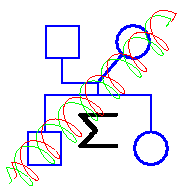
1. (based on Crow and Kimura, Ch 4, #15)
An individual B has phenylketonuria, a rare recessive condition, for
which the allele frequency q is 0.01. What is the probability that
B's relative C has phenylketonuria if
(a) C is a nephew of B
(b) C is a double first cousin of B
(c) C is a quadruple half first cousin of B
(Note the kinship coefficient between B and C is the
same for these three relationships)
2.
Consider a male with inbreeding coefficient f1 who is
unrelated to a female individual who has inbreeding coefficient f2.
The individuals have two offspring B and C.
(a) Show that the probabilities ki (i=0,1,2) that B and C
have i genes IBD are
k2 = (1 + f1)(1 + f2) /4
k0 = (1 - f1)(1 - f2) /4
k1 = 1 - k0 - k2
and that the coefficient of kinship between B and C is
psi(B,C) = (2 + f1 + f2) /8
(b) Suppose the first child has a recessive trait, the allele for
which has frequency q. If nothing is known about the trait in the
parents, what is the probability the second child will have this trait
also?
(c) Suppose the first child has a recessive trait, the allele for
which has frequency q. If nothing is known about the trait in the
parents,
what is the probability the second child will be an (unaffected)
carrier of the recessive allele?
(d) Suppose now it is known that neither parent has the trait, but
again the first child is affected.
What is the probability the second child will have this trait
also? What is the probability the second child will be an unaffected
carrier of the recessive allele?
3. Suppose a pair of full sibs F and G share neither of their genes IBD
(an event which has probability 1/4).
Given this, a
third unilateral non-inbred
relative H may share a gene IBD
with each of F and G,
with F but not with G,
with G but not F,
or with neither.
That is, the four ibd states can be written
1 2 3 4 1 3, 1 2 3 4 1 5, 1 2 3 4 3 5, and 1 2 3 4 5 6.
Given that F and G share no genes ibd,
if H is an aunt of F and G, the conditional
probabilities of these four states are 1/4 each,
while if H is a half-sister
of F and G the probabilities are 0,1/2,1/2,0 respectively.
You do not have to show this!.
Suppose at a marker locus the genotypes of F, G and H are ab, cd, and ac,
respectively
where the a,b,c,d alleles have population frequencies
qa
qb
qc and
qd.
Find the probability of these data if
(a) H is an aunt of sibs F and G.
(b} H is a half-sister of sibs F and G.
4. (a) Regardless of genetic interference,
show that if the probability of more than one crossover in a small
sement of chromosome in an offspring gamete is negligible,
then the recombination probability between loci at the two ends
of the segment is approximately the genetic distance.
(b) Regardless of genetic interference,
show that recombination probabilities are subadditive. That is, if
r1 and r2 are the recombination probabilities in
adjacent intervals, then the recombination r between the end points of the
combined interval is no greater than r1+r2.
When does r = r1+r2?
(c) (Lange, Chapter 7: number 1)
In this part of the question, assume absence of genetic interference;
i.e. Haldane's map function.
Suppose loci are ordered, 1,2,3,...,L along a chromosome, and rj
is the recombination frequency between locus j and locus j+1.
Show that
the recombination frequency r
between locus 1 and locus L satisfies the formula
(1- 2 r) is the product of the (1- 2 rj).
(Hint: convert to genetic distance.)
(d) The Kosambi map function is r(d) = (e4d -1)/2(e4d+1).
Suppose the recombination frequency between the ends of an interval is r.
Show that the genetic length of the interval is a larger number of Haldane
centiMorgans than it is Kosambi centiMorgans. Using the fact that the
Kosambi map function expresses positive interference, reconcile the fact
that Kosambi centiMorgans are ``larger''
with the fact that, in both cases,
a Morgan (Haldane or Kosambi) is the genetic distance within which 1
crossover is expected.